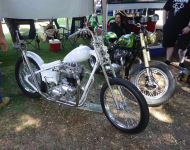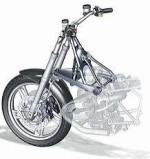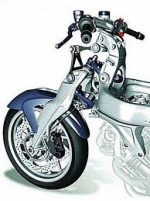ebike4healthandfitness
10 kW
- Joined
- May 19, 2012
- Messages
- 777
Normally I would say 30 mph. This mainly because under heavy braking (with sticky tires) I can see my front hub pulling rearward (essentially steepening the head tube angle) during which time the top tube is experiencing heavier than normal tension forces and the down tube is experiencing heavier than normal compression forces.
If that could be fixed I might be willing to go over 30 mph on a closed course. This assuming, of course, the bike is also sufficiently balanced and low center of gravity (e.g. think shorter than normal cranks to allow lower BB height while still allowing sufficient ground clearance).
Some examples of fully rigid bikes and fully rigid mobility devices going very fast would be Tour de France riders going downhill (60+ mph ) on those very narrow high pressure tires. Another example of fully rigid going fast is the Rion RE90 electric kick scooter which is 80 mph (only requiring part throttle) on very small diameter wheels.
If that could be fixed I might be willing to go over 30 mph on a closed course. This assuming, of course, the bike is also sufficiently balanced and low center of gravity (e.g. think shorter than normal cranks to allow lower BB height while still allowing sufficient ground clearance).
Some examples of fully rigid bikes and fully rigid mobility devices going very fast would be Tour de France riders going downhill (60+ mph ) on those very narrow high pressure tires. Another example of fully rigid going fast is the Rion RE90 electric kick scooter which is 80 mph (only requiring part throttle) on very small diameter wheels.
Last edited:




